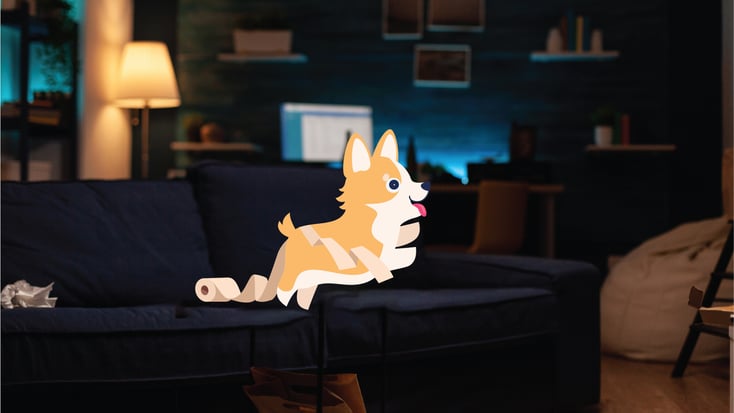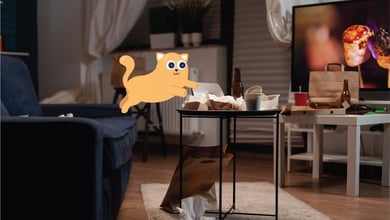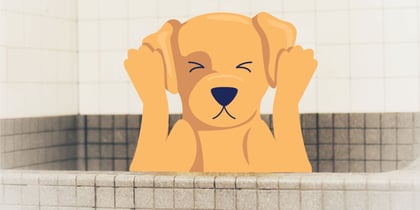Dog Zoomies: Why Do They Get Them?

Table of Contents
Ever wondered why your dog suddenly goes into a frenzy, dashing around with excitement? These energetic bursts, known as dog zoomies or Frenetic Random Activity Periods (FRAPs), are a common behavior among our canine companions.
In this article, we'll explore the reasons behind dog zoomies and discover effective ways to help calm your pup during these lively episodes. Understanding the causes behind their energetic outbursts can lead to a happier and more harmonious relationship with your furry friend.
Key Takeaways:
- Dog zoomies, also known as Frenetic Random Activity Periods (FRAPs), are sudden bursts of energy and hyperactive behavior displayed by dogs.
- Trying to stop a dog mid-zoomies session is often challenging, so it's best to wait it out as these episodes are usually short-lived.
- Consult a veterinarian or animal behaviorist if your dog's zoomies become frequent or are accompanied by destructive or aggressive behavior.
What Are Dog Zoomies?
Dog zoomies, also known as Frenetic Random Activity Periods (FRAPs), refer to sudden bursts of energy and hyperactive behavior displayed by dogs. During zoomies, dogs may run around in circles, jump, bark, and engage in playful antics.
Why Do Dogs Get the Zoomies?
Dogs get the zoomies when they have pent-up energy, either physical or emotional, that needs to be released. This can occur after being crated, lacking exercise, or enduring stressful situations. Let's explore some of these common reasons:
1. They're Excited
Dogs may exhibit zoomies when they are overwhelmed with excitement, especially during reunions with their owners after separation.
2. They've Been Inactive or Sleeping
Dogs are more prone to zoomies after periods of inactivity or long periods of sleep, particularly in the morning or evening when they may have built up pent-up energy.
3. They've Just Had a Bath
Bath time can trigger zoomies in dogs, possibly due to feeling relieved, invigorated, or seeking attention and praise from their pet parents.
4. They're Feeling Stressed
Stressful situations or triggers, such as meeting unfamiliar dogs or being separated from their owners, can lead to Zoomies' behavior as a way for dogs to release their nervous energy.
5. They're Bored
Dogs require mental and physical stimulation to stay engaged and content. When they lack sufficient attention or stimulation, boredom can occur, resulting in restlessness and Zoomies episodes.
6. They're Teething or Physically Uncomfortable
Puppies going through teething or dogs experiencing physical discomfort may resort to zoomies to alert their owners or escape from discomfort.
How to Stop Dog Zoomies
To manage your dog's zoomies, providing regular exercise, engaging mental activities, and a serene environment is essential. A good bedtime routine and positive reinforcement training also play a role.
Here are some tips to help manage dog zoomies further explained:
1. Provide regular exercise
To reduce frequent zoomies, make sure your puppy or dog gets plenty of exercise and activity throughout the day. Walks, fetch games, mental challenges, and chewing on toys or bones are great ways to burn off their energy.
2.Mental stimulation
Engage your dog in mentally stimulating activities, such as puzzle toys or obedience training, to keep their minds occupied.
3. Establish a bedtime routine
Create a calming bedtime routine with dim lighting, comfortable bedding, or a crate to help your puppy know when it's time to sleep and be relaxed.
4. Calm environment
Create a calm and peaceful environment for your dog, especially when they are prone to zoomies, such as bedtime.
5. Train for good behavior
Positive reinforcement training can teach your pup good behavior and self-control. Use rewards for positive actions and teach basic commands like "sit," "stay," and "come" to manage their behavior.
6. Address separation anxiety
If your dog experiences separation anxiety, gradually acclimate them to being alone by starting with short periods of alone time and gradually increasing it. Crate training can also provide a safe space and reduce destructive behavior.
If your dog frequently displays zoomies or exhibits destructive or aggressive behavior, consult a veterinarian or animal behaviorist for additional guidance.
Puppy Zoomies
Puppy zoomies are similar to dog zoomies but are often more frequent due to their high energy levels and playful nature. Puppies may experience zoomies during specific times, such as mornings or evenings when they have extra energy or adjust to their surroundings. Proper exercise, mental stimulation, and structured playtime can help manage and minimize puppy zoomies.
Related reading: Puppy First Vet Visit: What You Can Expect
Conclusion
In conclusion, dog zoomies are a natural behavior that dogs display to release their excess energy. By providing exercise, mental stimulation, and a calm environment, you can help manage their zoomies.
However, if your dog's zoomies become frequent or are accompanied by destructive or aggressive behavior, it's important to seek guidance from a veterinarian or animal behaviorist. They can provide the necessary support and advice to ensure your dog's well-being.
Keep reading: 11 Signs Your Pet Needs to See a Veterinarian
Frequently Asked Questions
Are zoomies a sign of a happy dog?
Zoomies are often a sign of a happy dog. They are a way for dogs to release pent-up energy and express joy and excitement.
Is it bad if my dog doesn't get the zoomies?
It's not necessarily bad if your dog doesn't get the zoomies. Some dogs may have lower energy levels or express their happiness and playfulness in different ways.
Why does my puppy go crazy at night?
Your puppy is likely experiencing Frenetic Random Activity Periods (FRAPs) or puppy zoomies at night. This is because your puppy is burning off the last of their energy before preparing for sleep, may be anxious about being separated from you, or they may be teething. Your veterinarian can help you discover the cause of your puppy's zoomies, but it is usually completely normal.
Why do dogs get zoomies after a bath?
Dogs may get zoomies after a bath because they feel relieved, invigorated, or seek attention and praise from their pet parents.
Why do dogs get zoomies after pooping?
Dogs may get zoomies after pooping to release built-up energy and express their joy and relief after completing a necessary bodily function.
Why is my puppy hyper and biting at night?
Again, this behavior is likely to be puppy zoomies and a way to use up excess energy. Puppies get excited and playful and, due to teething, tend to chew things and bite other pets and their pet parents. Redirecting this energy into a desired behavior is best by offering chew toys and some additional playtime before bedtime.
What age do puppy zoomies stop?
Zoomies don't usually stop when puppies reach adulthood, although they are more infrequent in older dogs. As long as your puppy's or dog's zoomies aren't causing any issues, this behavior is completely normal and part of your dog's playful personality.






